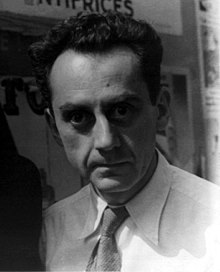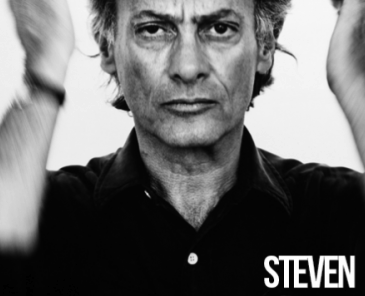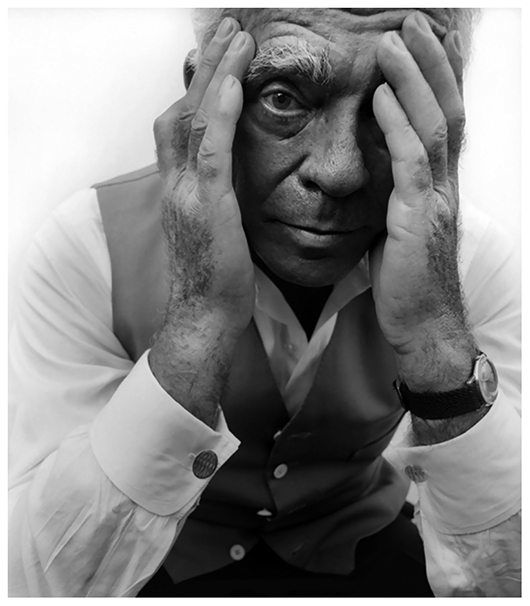Man Ray, pseudonym Emmanuel Radnitzky (Philadelphia, August 27, 1890-Paris, November 18, 1976) was an American visual artist who spent most of his career in Paris France). He was a major contributor to the Dada and Surrealist movements, though his ties to each were informal. He worked in various media but considered himself primarily a painter. He was known in the art world mostly for his avant-garde photography, and was also a renowned portrait and fashion photographer.
During his long artistic career, he tried to keep almost no details of his life or family known, even going so far as to deny that he had any name other than Man Ray.
he was born Emmanuel Radnitzky in Philadelphia, Pennsylvania on August 27, 1890, the eldest son of a Jewish immigrant couple. He had a brother and two younger sisters and his father was a tailor. In early 1912 the family changed the surname to Ray to avoid discrimination and anti-Semitism and then Emmanuel, familiarly called 'Manny', also changed his name to Man and began using Man Ray as a given name.
Both Man and his siblings helped his father in tailoring since they were children and his mother supplemented the family income by doing patchwork work, quilts made from patchwork of fabric. Man Ray always wanted to disassociate himself from his family origins but clearly the tailoring technique and materials are present in his work from the beginning. Art historians note the similarities of his collages with patchwork. Mason Klein, curator of the Jewish Museum in New York, suggests that the artist may have been "the first avant-garde Jewish artist."
he displayed artistic and technical ability as a child, and while going to school, he frequently visited local museums, where he studied the works of the old masters. After graduating from high school, he was offered a scholarship to study architecture, but he turned it down, determined to continue on as an artist. His parents were a bit disappointed with his decision, but they helped him convert a couple of rooms in the family home into a study. For the next four years he looked for work as a painter. In New York he worked as an engraver and in an advertising agency, while attending evening classes at the National Academy of Design. Surviving work from this period shows that he followed the academic style of the 19th century as his first contacts with the New York avant-garde came in his visits to Alfred Stieglitz's gallery and at the Arensberg gatherings.
In 1914 he married Adon Lacroix (Donna Lecoeur, 1887-1975), a Belgian anarchist poet. They separated in 1919 and were formally divorced in 1937. His first solo exhibition takes place at the Daniel Gallery in New York in 1915, featuring Cubist-influenced paintings. Shortly after, together with Marcel Duchamp and Francis Picabia, he founded the New York Dada movement.
In 1918 he worked with airbrushes for the first time on photographic paper and in 1920, with K. Dreier and M. Duchamp, he founded Société Anonyme, a company from which they manage all kinds of of avant-garde activities (exhibitions, publications, installations, films, conferences, etc.). But for Ray, such experimentation was no match for the wild and chaotic streets of New York: "Dada can't live in New York. All of New York is Dada and will not tolerate a rival."
Thus, in 1921 he settled in Paris, where he lived until 1940, and there he centralized the Parisian Dada. Faced with the impossibility of selling his work, Man Ray returns to photography. His first experimental works are the Rayographs (rayograms) of 1921, photographic images taken without a camera (abstract images obtained with objects exposed on a light-sensitive paper and then developed). He also makes portraits, in fact he becomes a portrait photographer for cultural personalities.
When Surrealism separated from Dada in 1924, Ray is one of its founders and is included in the first Surrealist exhibition at the Pierre Gallery in Paris in 1925.
he Makes Surrealist sculptures modeled on the found art created by Marcel Duchamp, such as Object to be Destroyed from 1923; Man Ray added to a normal metronome, 26 cm high, the photograph of an eye on the needle. Nine years later, Man Ray is abandoned by his partner, Lee Miller, as a result of which Man Ray replaced the eye of an unknown person with that of his ex-lover, and changed the title of the ready-made to Object. of destruction. In 1957, a group of students actually destroyed the metronome, but Man Ray rebuilt it in 1963, and definitively titled it Indestructible Object, giving the work a conceptual twist. In the Reina Sofía Museum there is a giant-scale reproduction of this work preserved in the Museum of Modern Art in New York.
Inspired by his Parisian model and lover Alice Prin, known as Kiki de Montparnasse, he takes the photograph Le Violon d'Ingres (1924).
In 1929 he filmed, mainly at Villa Noailles, his short film Les Mystères du Château de Dé.
In the thirties he made the series of solarizations, photographic negatives exposed to light, and continued to paint in a surrealist style; he publishes several volumes of photographs and rayograms. Towards the end of the twenties he began to make avant-garde films, such as La estrella de mar (1927). In 1936 his work is present in the exhibition "Fantastic Art, Dada and Surrealism" at the Museum of Modern Art in New York.
In 1940, escaping from the Nazi occupation of Paris (1940-1944), he settled in Hollywood and New York. While in California he makes a living teaching as a teacher. In 1946 he married Juliette Browner, in a double wedding along with that of Max Ernst and Dorothea Tanning.
Ray's fertile production eschews neat categorization and reflects his snappy, humorous sensibilities. Paintings and photographs include films, objects, collages, graphic work, drawings, advertising design and fashion. As a pioneer of dada and surrealism, his approach is characterized by the irrational and incongruous, provoking eroticism and scandal. «The search for freedom and pleasure; that occupies all my art », he will say.
he returned to France in 1951. In 1963 he published his Autobiography. In 1973, the Metropolitan Museum in New York dedicated a retrospective to his photographic work. He died on November 18, 1976, in Paris, at the age of 86. His remains rest in the Montparnasse Cemetery.
(Source Wikipedia)
Take a look at some of his photos








 English (United Kingdom)
English (United Kingdom)